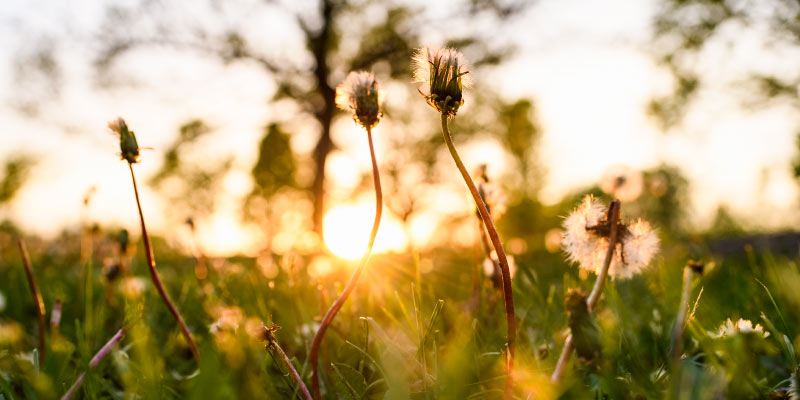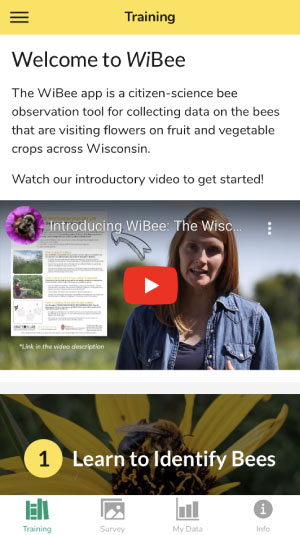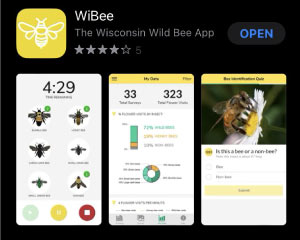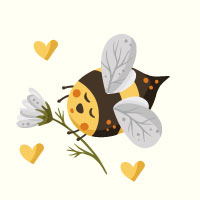
With the help of an app developed by University of Wisconsin–Madison entomologists, Sun Prairie residents are becoming scientists studying bees in their own yards this May.
The city of Sun Prairie, Wisconsin, located northeast of Madison, is participating in the No Mow May conservation initiative for the second year. With support from Thriving Earth Exchange — an AGU program that advances local solutions to community priorities — the city hopes to expand on results of the first year by collecting more robust information from community members.
“We wanted to enable our community to explore different mowing strategies during a critical early foraging season for pollinators, and we did,” Sun Prairie sustainability coordinator Scott Semroc said. “The Sun Prairie community interest and response was incredible.”
In 2022, 342 properties registered to participate in the conservation initiative with most participants opting to refrain from mowing for the entire month of May. But Semroc said about 95 expressed interest in participating as citizen scientists. “What I noticed is that we simply ran out of time and capacity to fully realize one of our secondary objectives, which was community science and resident education,” Semroc said about the pilot year.
Through Thriving Earth Exchange, which is supported by UniverCity Alliance (UCA) and Educational Partnerships for Innovation in Communities Network (EPIC-N), Sun Prairie connected with two UW–Madison entomologists who are supporting data collection through the Wisconsin Wild Bee App (WiBee) data analysis and educational efforts.
In 2023, those who want to take No Mow May to the next level can observe pollinator activity and contribute their observations to WiBee (pronounced Wee-bee). The data collected will help scientists determine how pollinators are affected by mowed versus unmowed lawns.

and the Apple App Store.
Semroc said the partnership with Thriving Earth Exchange provided the resources not only to collect data specific to Sun Prairie, but also to help residents get involved in No Mow May in multiple ways. Community members can participate by mowing less frequently and take the extra step and track how pollinators react to their yards. “That capacity building, the education, and having a ready-made app — city staff and researchers alike often don’t have app development resources available,” Semroc said. “Having everything in one place is immensely valuable for us.”
Sun Prairie’s No Mow May effort is one of 14 projects being conducted in Thriving Earth Exchange’s cohort of Wisconsin communities. The program pairs participating communities with a community science fellow, like a volunteer project manager, who then connects them with technical experts.
“By having the space to ask a question that is pertinent to their community, Sun Prairie’s sustainability team is demonstrating the impact the process of community science can have, while also allowing residents the opportunity to actively participate in an issue they care about,” AGU Thriving Earth Exchange director Natasha Udu-gama said.
This is also a first-of-its-kind partnership where Thriving Earth is working with a statewide cohort. UCA, housed on UW–Madison’s campus, connects local governments across the state with university resources to solve community problems. The goals of UCA — supporting communities to become sustainable and resilient — align with Thriving Earth Exchange.
 “We know that universities have a lot to offer and learn from communities, but sometimes there’s no structure to unlock the potential of these partnerships,” UCA managing director Gavin Luter said. “Thriving Earth Exchange is a fellow traveler in the journey of creating such structures to facilitate community-university partnership, and I think this project show’s what’s possible when these structures are activated.”
“We know that universities have a lot to offer and learn from communities, but sometimes there’s no structure to unlock the potential of these partnerships,” UCA managing director Gavin Luter said. “Thriving Earth Exchange is a fellow traveler in the journey of creating such structures to facilitate community-university partnership, and I think this project show’s what’s possible when these structures are activated.”
‘Patchy’ Resources
First popularized in Appleton, Wisconsin, No Mow May is a conservation initiative that asks property owners to limit mowing during May — a crucial time for pollinators — to provide more foraging resources in urban landscapes when few floral options are typically available.
This is important for bumble bees, which emerge in spring and fly all summer into early fall, and solitary wild bees that only fly for short periods in the spring. Hannah Gaines Day, a research scientist at UW–Madison’s department of entomology in the Gratton Lab, said resources for pollinators are “patchy” during May in Wisconsin when temperatures vary.
“In No Mow May, what we’re hoping is that people can provide resources during this time of year when there aren’t many that will help the bees to survive the spring, get to the summer, and to provision their offspring with food,” Gaines Day said.
Gaines Day and Genevieve Pugesek, a postdoctoral researcher in the same lab, were connected to Sun Prairie after the project’s community science fellow, 1000 Friends of Wisconsin’s community programs director Susan Gaeddert, reached out to the Gratton Lab. The No Mow May project sparked their interest because of their extensive background studying wild pollinators, managed honeybees, and bumble bees. Additionally, Gaines Day said the city’s project was a “perfect partnership” for the WiBee app.
WiBee was designed to be a tool for growers. However, Gaines Day said the app’s convenient way of collecting data on insects visiting flowers prompted interest from non-grower groups. “Even though the ultimate idea has always been that it will be a tool for farmers, other people have embraced it, and it’s become mostly non-farmers using it,” Gaines Day said. “This seemed like a perfect opportunity to use it.”
Inspiring Pollinator-Friendly Actions
Participating Sun Prairie residents will choose a section of lawn they want to study and only mow half of it, leaving the other half growing for the entire month. Then, they will document their observations. The city also plans to create a few demonstration plots to showcase what this approach will look like, and take additional observations at these locations. One example is at Sheehan Park, which is located across from the Sun Prairie Public Library.
The reason for this, Gaines Day said, is that bees are sensitive to differences in microclimates, like whether a part of the yard is sunny or shady. “What we want them to do is have a mow and no mow (area) that’s basically the same microclimate, so that the differences that they see, we can attribute to them mowing or not mowing,” Gaines Day said.
Pugesek highlighted the outreach component of the community initiative. Being aware of pollinator gardens and No Mow May signs can prompt community members to think about science in a new way. The No Mow May program can also encourage people to take stock of the natural environment they have immediately around them in their yards and inspire them to protect pollinators in other ways, like growing more pollinator-friendly plants.
While not everyone may appreciate a shaggy, unkempt lawn, the benefits are real. Studies in the United States show that dandelions and clover support a high diversity of bees and that reduced mowing can lead to higher bee abundance.
“Seeing the excitement and the enthusiasm that the community has shown over supporting pollinators has been really awesome and super great, even if that means giving up having a nice, neat lawn for a little while during the springtime,” Pugesek said.
Overall, Pugesek said a benefit of the Thriving Earth Exchange partnership was formalizing the relationship, which prevents the project from falling to the wayside. “We’re there for multiple steps in the process,” Pugesek said. “That’s been really useful just in terms of making sure that this stays a collaborative effort.”
 How to Embrace to No Mow May
How to Embrace to No Mow May
Interested in adopting No Mow May in your lawn? Here are some tips to get you started.
- First, check the rules.
Make sure your community or homeowners association doesn’t have any rules prohibiting overgrown lawns. And if they do, seize the learning opportunity! PennState Extension offers a robust myth-busting fact sheet to help you start the conversation. - Add a sign.
If worrying what the Joneses will think is holding you back, consider installing an informational sign in your yard. Bee City USA offers a free toolkit, including printable signs and social media posts for you to share with your community. - “Low mow” is an option, too.
Just can’t bring yourself to let the lawn go? “Low Mow May” (or even “Low Mow Spring”) is a great second option. Try going an extra week between mowings or bring your blade height up. (The latter is a good lawn-care habit anyway, says UW–Madison professor Doug Soldat.) - Download WiBee!
Already a no-mow expert? If you live in Wisconsin, take No Mow May to the next level by downloading the free WiBee app and tracking pollinator activity in your yard.